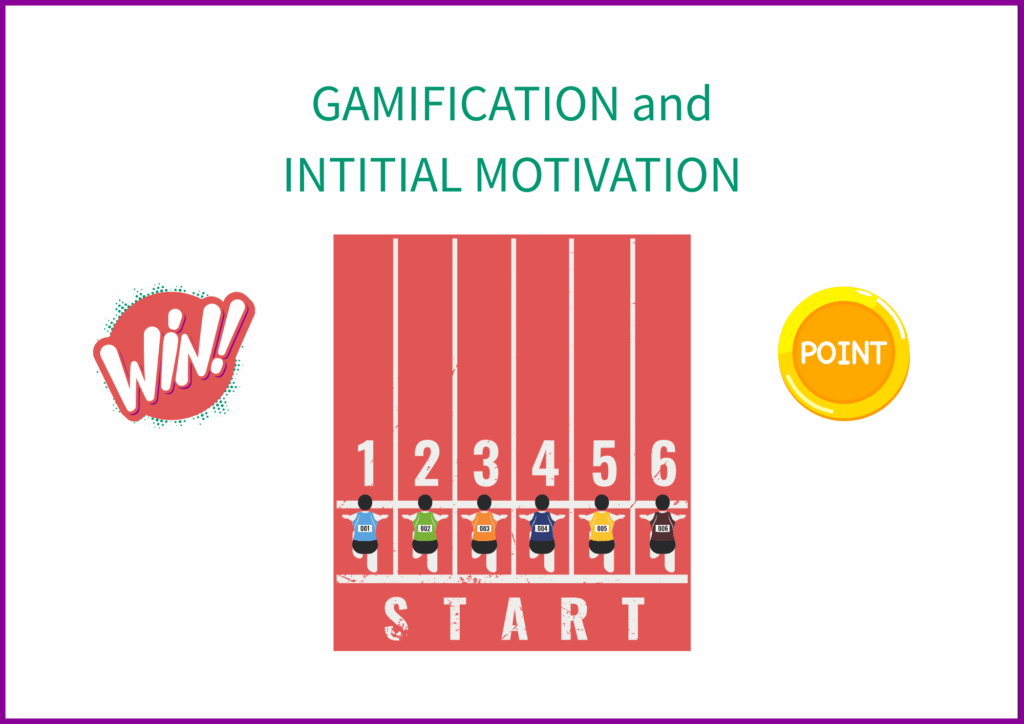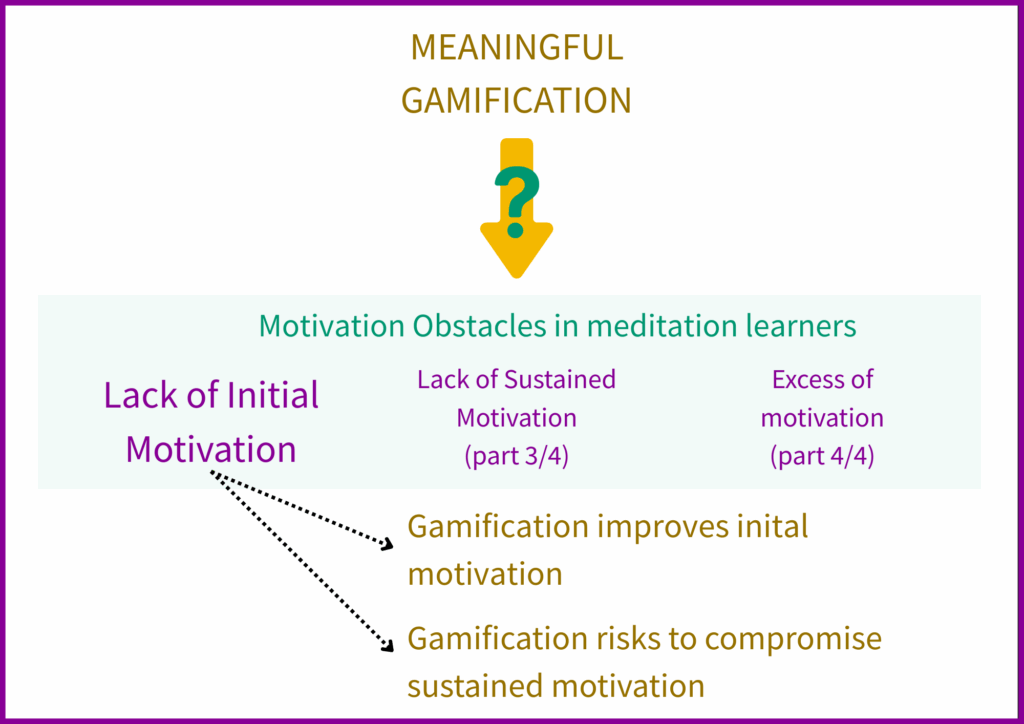Gamification, Presence and Awareness (Part 2/4)

Gamification is widely known for its attractive reputation for improving learners’ engagement. But is that the complete truth about gamification? Various meta-analysis research demonstrated that it is the case, but as always with its own limits and practices (Li, Ma, & Shi, 2023; Sailer & Homner, 2020). The second research shows that gamification has the capacity to ignite interest and motivation in students with an effect size ranging from 0.18 to 0.54, which is a small but significant effect (Sailer & Homner, 2020). The first research however found a significantly higher effect size of 2.206 (Li, Ma, & Shi, 2023). This difference highlights the contentious realm of research within gamification but also the fact that there is a direct correlation between gamification and an increase in motivation. Both studies explain that gamification has the ability to motivate initially, but that some better care needs to be put in place for more sustained motivation.
An example that shows this improvement of initial motivation is the increase of usage in mindfulness applications when they are coupled with gamification (Tanrıkulu & Demirel, 2023). Indeed, this study shows that the game mechanics used in these apps, based on extrinsic rewards such as points, have become a powerful selling tool, meaning an increase in user engagement. In more detail, the paper explains that there are mainly two types of rewards used: tangible (ie. coupons) and intangible (virtual items like points, badges,..).

Another example is the Brain Booth initiative (Karadjova, 2018). This initiative proposes a space for communities of students to explore the benefits of mindfulness for their learning. A pre-arranged environment with activities and games is created on campus, and students have the chance to spend time in the Brain Booth during their break. The study demonstrates a high correlation between the gamified elements of this initiative and the use of the space by students. The playful touch ignited the initial motivation of students to use it and discover the benefits of mindfulness.
There are however some cautions to take when it comes to using gamification to enhance meditation. Some very recent articles explain the pros and cons of all the gamified mechanics and elements used in enhancing mindfulness (Thomma, 2025). For example, Thomma explains that the use of streak seems to be a good idea to create some initial motivation, but in the long run, if one loses the streak, it creates the risk of generating a feeling of not being good enough, affecting sustained motivation.

Continue to Gamification, Presence and Awareness (Part 3/4)
Go back to Gamification, Presence and Awareness (Part 1/4)
References:
Alsawaier, R. S. (2018). The effect of gamification on motivation and engagement. The International Journal of Information and Learning Technology, 35(1), 56-79.
Amaro, A. (2018). ‘I’m Not Getting Anywhere with my Meditation…’: Effort, Contentment and Goal-directedness in the Process of Mind-training. Buddhist Studies Review, 35(1-2), 47-64.
Britton WB, Lindahl JR, Cahn BR, Davis JH, Goldman RE. (2014). Awakening is not a metaphor: the effects of Buddhist meditation practices on basic wakefulness. Ann N Y Acad Sci. Jan;1307:64-81. doi: 10.1111/nyas.12279.
Brown, K. W., Berry, D., Eichel, K., Beloborodova, P., Rahrig, H., & Britton, W. B. (2022). Comparing impacts of meditation training in focused attention, open monitoring, and mindfulness‐based cognitive therapy on emotion reactivity and regulation: neural and subjective evidence from a dismantling study. Psychophysiology, 59(7), e14024.
Chapman, J. R., Kohler, T. B., Rich, P. J., & Trego, A. (2025). Maybe we’ve got it wrong. An experimental evaluation of self-determination and Flow Theory in gamification. Journal of Research on Technology in Education, 57(2), 417-436.
Coquillard, A. (2024). Assessment task 1 – Literature review in educational design graduate certificate unit EDF5768 – Educational design. Monash University.
Coquillard, A. (2025). Assessment task 1 – Compendium in educational design graduate certificate unit EDF5772 – Innovations in technologies and pedagogical practices. Monash University.
Dahl, C. J., Lutz, A., & Davidson, R. J. (2015). Reconstructing and deconstructing the self: cognitive mechanisms in meditation practice. Trends in cognitive sciences, 19(9), 515-523.
Donald, J. N., Bradshaw, E. L., Ryan, R. M., Basarkod, G., Ciarrochi, J., Duineveld, J. J., … & Sahdra, B. K. (2020). Mindfulness and its association with varied types of motivation: A systematic review and meta-analysis using self-determination theory. Personality and Social Psychology Bulletin, 46(7), 1121-1138.
Galla, B. (2024). How motivation restricts the scalability of universal school‐based mindfulness interventions for adolescents. Child Development Perspectives, 18(3), 129-136
Ge, Y., & Han, T. (2021). MindJourney: Employing gamification to support mindfulness practice. In Advances in Usability, User Experience, Wearable and Assistive Technology: Proceedings of the AHFE 2021 Virtual Conferences on Usability and User Experience, Human Factors and Wearable Technologies, Human Factors in Virtual Environments and Game Design, and Human Factors and Assistive Technology, July 25-29, 2021, USA (pp. 228-235). Springer International Publishing.
Kabat-Zinn, J. (2017). Common obstacles to practice. Mindfulness, 8(6), 1713-1715.
Kapp, K. M. (2012). The gamification of learning and instruction: game-based methods and strategies for training and education. John Wiley & Sons.
Karadjova, K. (2018). Mindfulness and gamification in the higher education classroom: Friends or foes?. In 4th International Conference on Higher Education Advances (HEAD’18) (pp. 1089-1097). Editorial Universitat Politècnica de València.
Krishnamurti, J. (1956). Education and the significance of life. New-York: Haper Collins publishers.
Li, L., Hew, K. F., & Du, J. (2024). Gamification enhances student intrinsic motivation, perceptions of autonomy and relatedness, but minimal impact on competency: a meta-analysis and systematic review. Educational technology research and development, 72(2), 765-796.
Li, M., Ma, S., & Shi, Y. (2023). Examining the effectiveness of gamification as a tool promoting teaching and learning in educational settings: a meta-analysis. Frontiers in Psychology, 14, 1253549
Ling, L. T. Y. (2018). Meaningful Gamification and Students’ Motivation: A Strategy for Scaffolding Reading Material. Online Learning, 22(2), 141-155.
Malone, T. W., & Lepper, M. R. (2021). Making learning fun: A taxonomy of intrinsic motivations for learning. In Aptitude, learning, and instruction (pp. 223-254). Routledge.
Mullins, J. K., & Sabherwal, R. (2018). Beyond enjoyment: a cognitive-emotional perspective of gamification.
Nicholson, S. (2015). A recipe for meaningful gamification. Gamification in education and business, 1-20.
Norbu, C. N. (2013). The Mirror: Advice on Presence and Awareness (dran pa dang shes bzhin gyi gdams pa me long ma). Religions, 4(3), 412-422.
Ramírez-Barrantes, R., Arancibia, M., Stojanova, J., Aspé-Sánchez, M., Córdova, C., & Henríquez-Ch, R. A. (2019). Default Mode Network, Meditation, and Age‐Associated Brain Changes: What Can We Learn from the Impact of Mental Training on Well‐Being as a Psychotherapeutic Approach?. Neural Plasticity, 2019(1), 7067592.
Rivera, E. S., & Garden, C. L. P. (2021). Gamification for student engagement: a framework. Journal of further and higher education, 45(7), 999-1012.
Sailer, M., & Homner, L. (2020). The gamification of learning: A meta-analysis. Educational psychology review, 32(1), 77-112.
Tan, M., & Hew, K. F. (2016). Incorporating meaningful gamification in a blended learning research methods class: Examining student learning, engagement, and affective outcomes. Australasian Journal of Educational Technology, 32(5).
Tanrıkulu, G., & Demirel, B. (2023). Gamification in Mindfulness Mobile Applications: The Effects of Rewards on Purchase Intention. Optimum Ekonomi ve Yönetim Bilimleri Dergisi, 10(1), 125-142.
Thomma, N. (2025). Gamified Mindfulness: A Novel Approach to Nontraditional Meditation (Bachelor’s thesis, University of Twente)
Wang, C. J., Liu, W. C., Kee, Y. H., & Chian, L. K. (2019). Competence, autonomy, and relatedness in the classroom: understanding students’ motivational processes using the self-determination theory. Heliyon, 5(7).
Whitton, N., & Moseley, A. (2019). Playful learning. Events and activities to engage adults. New York.
Wuyts, P. (2020). From Excess to Exhaustion: The Rise of Burnout in a Post-modern Achievement Society. In Perception and the Inhuman Gaze (pp. 205-217). Routledge
Xi, N., & Hamari, J. (2019). Does gamification satisfy needs? A study on the relationship between gamification features and intrinsic need satisfaction. International Journal of Information Management, 46, 210-221.
Yavuz Sercekman, M. (2024). Exploring the sustained impact of the Mindfulness-Based Stress Reduction program: a thematic analysis. Frontiers in Psychology, 15, 1347336.